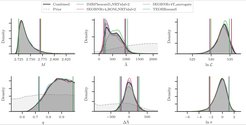Hypermodels help understand gravitational waves
A new approach to analyze binary neutron star mergers, developed by researchers from Potsdam University/the Max Planck Institute for Gravitational Physics and the University of London was published in Nature Astronomy today. Their innovative technique provides a proving ground for model development and a means to identify systematics in future gravitational-wave observations.
Paper abstract
Gravitational waves from the collision of binary neutron stars provide a unique opportunity to study the behaviour of supranuclear matter, the fundamental properties of gravity, and the cosmic history of our Universe. However, given the complexity of Einstein’s Field Equations, theoretical models that enable source-property inference suffer from systematic uncertainties due to simplifying assumptions. We develop a hypermodel approach to compare and measure the uncertainty gravitational-wave approximants. Using state-of-the-art models, we apply this new technique to the binary neutron star observations GW170817 and GW190425 and the sub-threshold candidate GW200311_103121. Our analysis reveals subtle systematic differences between waveform models, and a frequency-dependence study suggests that this is due to the treatment of the tidal sector. This new technique provides a proving ground for model development and a means to identify waveform systematics in future observing runs where detector improvements will increase the number and clarity of binary neutron star collisions we observe.

